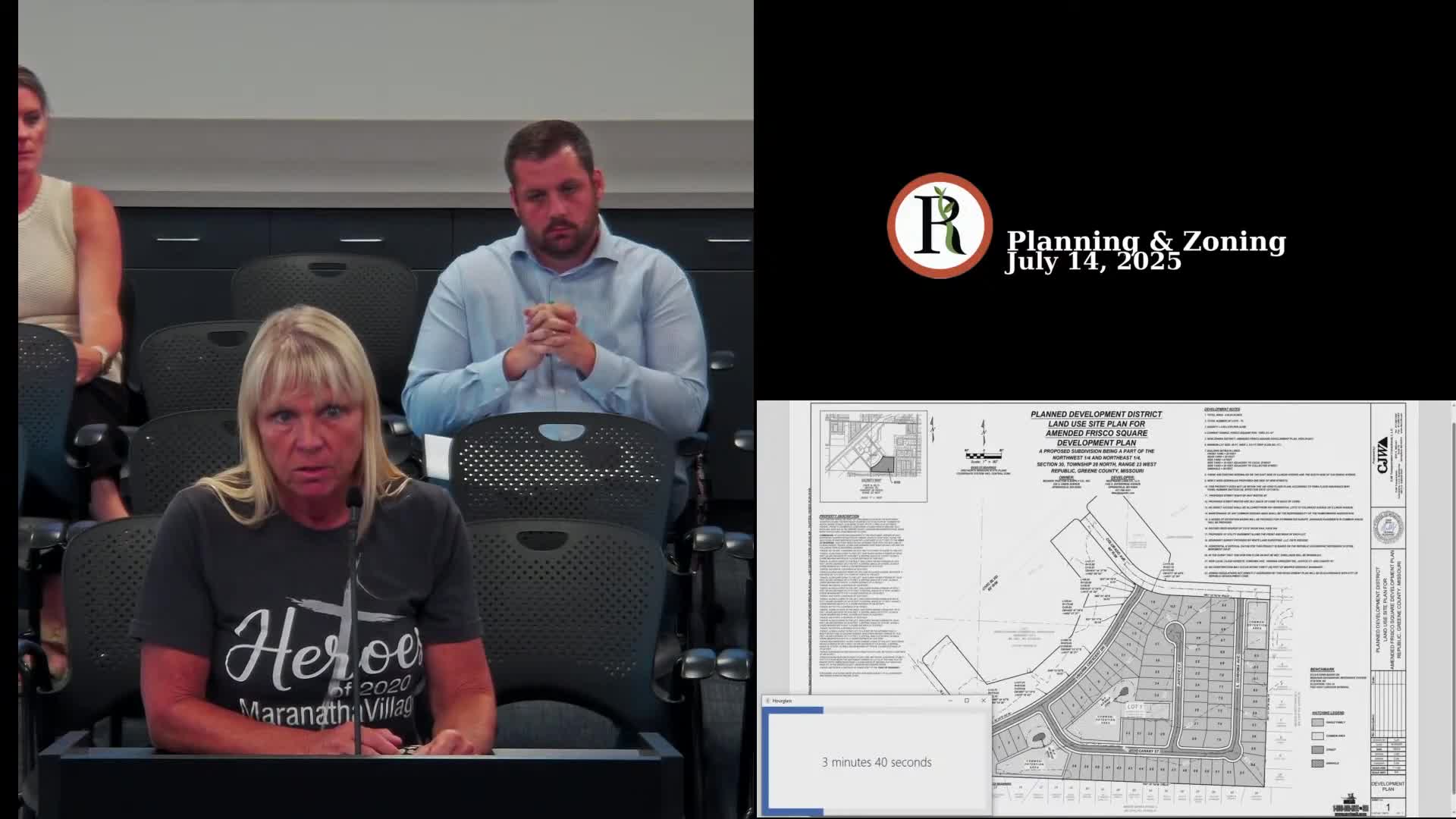Public Opposition Grows Over Frisco Subdivision Infrastructure Concerns
July 15, 2025 | Republic, Greene County, Missouri
This article was created by AI summarizing key points discussed. AI makes mistakes, so for full details and context, please refer to the video of the full meeting. Please report any errors so we can fix them. Report an error »

In a recent Planning and Zoning meeting held on July 14, 2025, the City of Republic faced significant discussions regarding a proposed subdivision that has raised concerns among residents and city officials alike. The meeting highlighted critical issues surrounding infrastructure capacity and the implications of potential zoning changes.
One of the primary voices of opposition came from a resident who expressed strong concerns about the current infrastructure's ability to support the proposed development. The resident argued that the existing roads and traffic management systems are inadequate for the anticipated increase in population and vehicle traffic. Suggestions were made to enhance the infrastructure, including adding stop signs, traffic lights, and widening roads to accommodate future growth. This sentiment reflects a broader anxiety within the community about the pace of development and its impact on daily life.
As the meeting progressed, city officials began to address specific concerns raised by residents, particularly regarding stormwater management and environmental considerations such as sinkholes and pesticide use. The city's engineer was invited to provide clarity on these issues, emphasizing the importance of addressing stormwater in the context of the proposed development.
A key point of discussion was the density of the proposed subdivision compared to existing developments in the area. The proposed plan suggests a lower density of 4.05 lots per acre, significantly reduced from the existing Planned Development District (PDD) density of 6.33 lots per acre. This reduction is seen as a positive step towards minimizing the environmental impact and reducing the number of vehicles and utility usage associated with the development.
However, city officials also noted that if the proposed changes to the PDD are not approved, the area would revert to the original, higher-density zoning established in the 1990s. This highlights the delicate balance the city must strike between accommodating growth and maintaining the quality of life for current residents.
The meeting concluded without a definitive resolution, leaving many questions unanswered regarding the future of the proposed subdivision and its implications for the community. As discussions continue, the city faces the challenge of ensuring that infrastructure keeps pace with development while addressing the concerns of its residents. The outcome of this proposal will likely shape the future landscape of Republic and its approach to urban planning.
One of the primary voices of opposition came from a resident who expressed strong concerns about the current infrastructure's ability to support the proposed development. The resident argued that the existing roads and traffic management systems are inadequate for the anticipated increase in population and vehicle traffic. Suggestions were made to enhance the infrastructure, including adding stop signs, traffic lights, and widening roads to accommodate future growth. This sentiment reflects a broader anxiety within the community about the pace of development and its impact on daily life.
As the meeting progressed, city officials began to address specific concerns raised by residents, particularly regarding stormwater management and environmental considerations such as sinkholes and pesticide use. The city's engineer was invited to provide clarity on these issues, emphasizing the importance of addressing stormwater in the context of the proposed development.
A key point of discussion was the density of the proposed subdivision compared to existing developments in the area. The proposed plan suggests a lower density of 4.05 lots per acre, significantly reduced from the existing Planned Development District (PDD) density of 6.33 lots per acre. This reduction is seen as a positive step towards minimizing the environmental impact and reducing the number of vehicles and utility usage associated with the development.
However, city officials also noted that if the proposed changes to the PDD are not approved, the area would revert to the original, higher-density zoning established in the 1990s. This highlights the delicate balance the city must strike between accommodating growth and maintaining the quality of life for current residents.
The meeting concluded without a definitive resolution, leaving many questions unanswered regarding the future of the proposed subdivision and its implications for the community. As discussions continue, the city faces the challenge of ensuring that infrastructure keeps pace with development while addressing the concerns of its residents. The outcome of this proposal will likely shape the future landscape of Republic and its approach to urban planning.
View full meeting
This article is based on a recent meeting—watch the full video and explore the complete transcript for deeper insights into the discussion.
View full meeting
